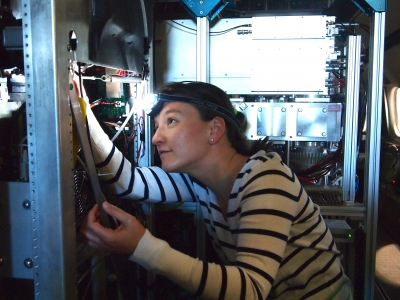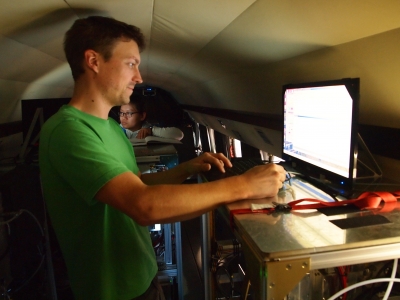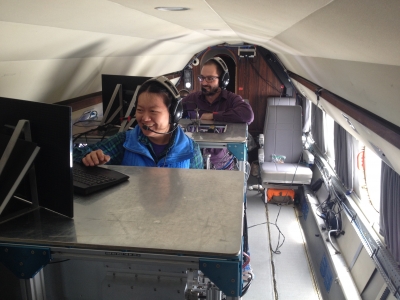
Editor’s note: Jerome Fast, the principal investigator of the Holistic Interactions of Shallow Clouds, Aerosols, and Ecosystems (HI-SCALE) campaign, sent this update.
We are into the second week of HI-SCALE, and have completed six research flights with the G-1 aircraft. Several people temporarily left the campaign earlier this week to participate in the ARM/ASR Principal Investigator’s Meeting in DC; however, we are in very capable hands. In addition to the ARM Aerial Facility (AAF) flight crew, we have four postdoctoral fellows—Tamara Pinterich, Siegfried Schobesberger, Jiumeng Liu, and Dave Bell—operating state-of-the-science instruments on the aircraft that are critical to the objectives of HI-SCALE. Jian Wang, Brookhaven National Laboratory, is Tamara’s mentor, Joel Thornton, University of Washington, is Siegfried’s mentor as part of his European Commission Marie Curie Fellowship, John Shilling, Pacific Northwest National Laboratory (PNNL), is Jiumeng’s mentor, and Alla Zelenyuk, PNNL, is Dave’s mentor.
One of the objectives of HI-SCALE is to understand the variable spatial and temporal distribution of atmospheric aerosols around the Southern Great Plains (SGP) site and characterize their growth to larger sizes that is relevant for cloud condensation nuclei. On some flights, Tamara found that high concentrations of small particles are present over a relatively large region and occur throughout the depth of the boundary layer, which might be related to new particle formation also observed by ground-based instruments. On other flights, high concentrations of small particles are confined to small regions that are likely associated with local emissions.

Siegfried is responsible for the High-Resolution Time of Flight Chemical Ionization Mass Spetrometer (HR-ToF-CIMS) throughout the campaign. The HR-ToF-CIMS is able to characterize very low concentrations of numerous trace gases at 2-second intervals including:
- oxidants tied to the multiphase processing of NOx and halogens,
- multifunctional organic nitrates and hydroperoxides derived from isoprene and monoterpene oxidation known to contribute to secondary organic aerosols (SOA), and
- a range of tracers that can be used to identify contributions from biogenic volatile organic compound oxidation, biomass/biofuel combustion, and coal/diesel combustion.
For HI-SCALE, Siegfried has modified the instrument to run in an additional ionization mode that widens the range of compounds that can be detected. Working together with the AAF crew, he modified the inlet tube to permit the calculation of eddy fluxes for many of the vapor compounds. So far, Siegfried has seen strong variations in isoprene oxidation products on some of the flights and this information will help shed light on the specific processes contributing to SOA formation. Siegfried is interested in using the field campaign data to better understand the details of new particle formation. The HI-SCALE campaign isn’t Siefried’s first ‘rodeo.’ He has collected measurements at the SMEAR II station in Hyytiala, Finland, and the Mace Head Atmospheric Research Station in Ireland, and has participated in Cessna research flights and a Zeppelin campaign, both in Finland. However, the present deployment of the HR-ToF-CIMS is the most complex instrument he has operated in the field so far.

Jiumeng and John are operating the High Resolution Time-of-Flight Aerosol Mass Spectrometer (HR-ToF-AMS) that measures the size and composition of non-refractory sub-micron aerosol properties at approximately 12-second intervals. Measurements from the HR-ToF-AMS will be used to quantify the chemical composition of particles that act as cloud condensation nuclei as well as particles within droplets. Detailed analyses after the campaign will provide information on the relative contribution of anthropogenic, biogenic, and biomass burning sources to SOA formation in the vicinity of the SGP site. With these measurements, Jiumeng is especially interested in identifying specific chemical processes that contribute to SOA formation as well as contrasting conditions within and outside of clouds and under different meteorological regimes. She is also very excited to participate in HI-SCALE, her first aircraft deployment and her first field campaign after joining PNNL.
Dave is diligently operating miniSPLAT for every research flight and he also helped deploy SPLAT II at the SGP Guest Facility at the beginning of the campaign. An Environmental Molecular Sciences Laboratory user facility, aircraft compatible single particle mass spectrometer, miniSPLAT characterizes the size and composition of individual aerosols with extremely high sensitivity, temporal resolution, and sizing precision on the order of a monolayer. In contrast with the HR-ToF-AMS, miniSPLAT is also able to characterize a wider range of aerosol composition, including dust, soot, and metals, as well as the mixing state of aerosols. Dave is finding that most particles are mixtures of organics, sulfate, and nitrate. He also found signatures of lead incorporated with dust particles on a few research flights, which agrees with characterization he has performed in the laboratory on dust particulates. Dave has extensive experience in collecting measurements during laboratory experiments, but this is the first time he has participated in a flight campaign.
While Tamara and Siegfried are eager to fly on the G-1 aircraft, they have not been able to be on board during the research flights due to the heavy payload of instruments already on the aircraft. Instead, Tamara, Siegfried, and myself patiently wait on the ground and follow what is happening during the flights using real-time data feeds. Over the upcoming months, I look forward to seeing the new scientific insights resulting from their analyses of the measurements.
It has been my pleasure to work with these young scientists in the field. In addition to demonstrating expertise in operating these instruments and interpreting the data, they have exhibited a great deal of professionalism throughout the campaign.

